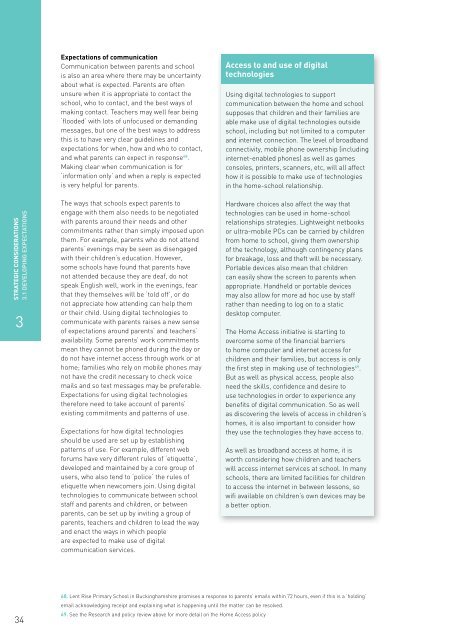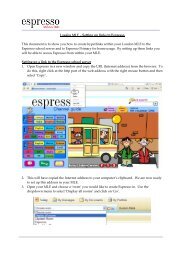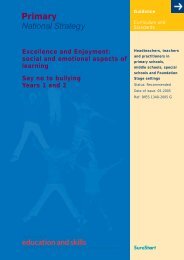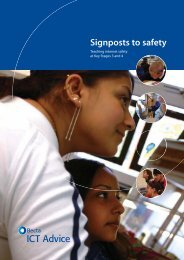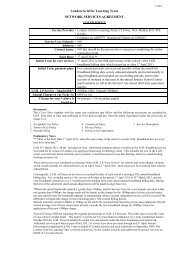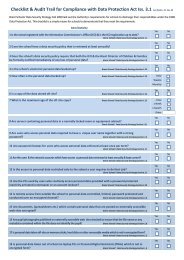Developing the home-school relationship using digital ... - Futurelab
Developing the home-school relationship using digital ... - Futurelab
Developing the home-school relationship using digital ... - Futurelab
- No tags were found...
You also want an ePaper? Increase the reach of your titles
YUMPU automatically turns print PDFs into web optimized ePapers that Google loves.
STRATEGIC CONSIDERATIONS3.1 DEVELOPING EXPECTATIONS3Expectations of communicationCommunication between parents and <strong>school</strong>is also an area where <strong>the</strong>re may be uncertaintyabout what is expected. Parents are oftenunsure when it is appropriate to contact <strong>the</strong><strong>school</strong>, who to contact, and <strong>the</strong> best ways ofmaking contact. Teachers may well fear being‘flooded’ with lots of unfocused or demandingmessages, but one of <strong>the</strong> best ways to addressthis is to have very clear guidelines andexpectations for when, how and who to contact,and what parents can expect in response 68 .Making clear when communication is for‘information only’ and when a reply is expectedis very helpful for parents.The ways that <strong>school</strong>s expect parents toengage with <strong>the</strong>m also needs to be negotiatedwith parents around <strong>the</strong>ir needs and o<strong>the</strong>rcommitments ra<strong>the</strong>r than simply imposed upon<strong>the</strong>m. For example, parents who do not attendparents’ evenings may be seen as disengagedwith <strong>the</strong>ir children’s education. However,some <strong>school</strong>s have found that parents havenot attended because <strong>the</strong>y are deaf, do notspeak English well, work in <strong>the</strong> evenings, fearthat <strong>the</strong>y <strong>the</strong>mselves will be ‘told off’, or donot appreciate how attending can help <strong>the</strong>mor <strong>the</strong>ir child. Using <strong>digital</strong> technologies tocommunicate with parents raises a new senseof expectations around parents’ and teachers’availability. Some parents’ work commitmentsmean <strong>the</strong>y cannot be phoned during <strong>the</strong> day ordo not have internet access through work or at<strong>home</strong>; families who rely on mobile phones maynot have <strong>the</strong> credit necessary to check voicemails and so text messages may be preferable.Expectations for <strong>using</strong> <strong>digital</strong> technologies<strong>the</strong>refore need to take account of parents’existing commitments and patterns of use.Expectations for how <strong>digital</strong> technologiesshould be used are set up by establishingpatterns of use. For example, different webforums have very different rules of ‘etiquette’,developed and maintained by a core group ofusers, who also tend to ‘police’ <strong>the</strong> rules ofetiquette when newcomers join. Using <strong>digital</strong>technologies to communicate between <strong>school</strong>staff and parents and children, or betweenparents, can be set up by inviting a group ofparents, teachers and children to lead <strong>the</strong> wayand enact <strong>the</strong> ways in which peopleare expected to make use of <strong>digital</strong>communication services.Access to and use of <strong>digital</strong>technologiesUsing <strong>digital</strong> technologies to supportcommunication between <strong>the</strong> <strong>home</strong> and <strong>school</strong>supposes that children and <strong>the</strong>ir families areable make use of <strong>digital</strong> technologies outside<strong>school</strong>, including but not limited to a computerand internet connection. The level of broadbandconnectivity, mobile phone ownership (includinginternet-enabled phones) as well as gamesconsoles, printers, scanners, etc, will all affecthow it is possible to make use of technologiesin <strong>the</strong> <strong>home</strong>-<strong>school</strong> <strong>relationship</strong>.Hardware choices also affect <strong>the</strong> way thattechnologies can be used in <strong>home</strong>-<strong>school</strong><strong>relationship</strong>s strategies. Lightweight netbooksor ultra-mobile PCs can be carried by childrenfrom <strong>home</strong> to <strong>school</strong>, giving <strong>the</strong>m ownershipof <strong>the</strong> technology, although contingency plansfor breakage, loss and <strong>the</strong>ft will be necessary.Portable devices also mean that childrencan easily show <strong>the</strong> screen to parents whenappropriate. Handheld or portable devicesmay also allow for more ad hoc use by staffra<strong>the</strong>r than needing to log on to a staticdesktop computer.The Home Access initiative is starting toovercome some of <strong>the</strong> financial barriersto <strong>home</strong> computer and internet access forchildren and <strong>the</strong>ir families, but access is only<strong>the</strong> first step in making use of technologies 69 .But as well as physical access, people alsoneed <strong>the</strong> skills, confidence and desire touse technologies in order to experience anybenefits of <strong>digital</strong> communication. So as wellas discovering <strong>the</strong> levels of access in children’s<strong>home</strong>s, it is also important to consider how<strong>the</strong>y use <strong>the</strong> technologies <strong>the</strong>y have access to.As well as broadband access at <strong>home</strong>, it isworth considering how children and teacherswill access internet services at <strong>school</strong>. In many<strong>school</strong>s, <strong>the</strong>re are limited facilities for childrento access <strong>the</strong> internet in between lessons, sowifi available on children’s own devices may bea better option.3468. Lent Rise Primary School in Buckinghamshire promises a response to parents’ emails within 72 hours, even if this is a ‘holding’email acknowledging receipt and explaining what is happening until <strong>the</strong> matter can be resolved.69. See <strong>the</strong> Research and policy review above for more detail on <strong>the</strong> Home Access policy


